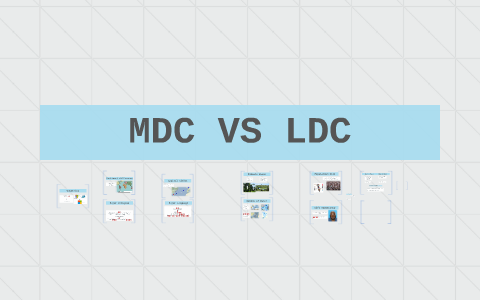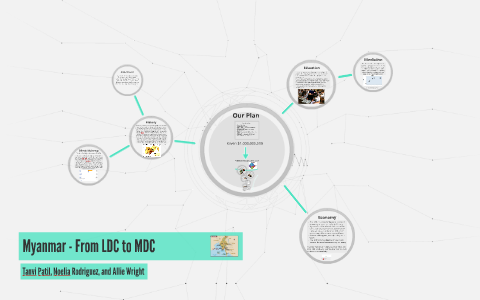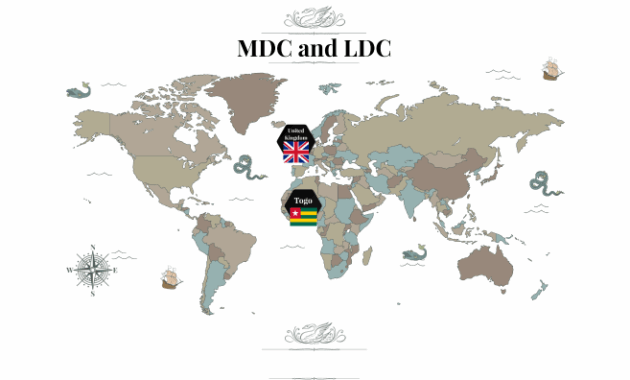The discourse surrounding MDC (More Developed Country) versus LDC (Less Developed Country) is foundational to understanding global economic and social disparities. It’s a complex topic, riddled with nuances that demand careful consideration. Rather than viewing these classifications as static labels, it’s more productive to see them as points along a spectrum of development, recognizing the dynamic and evolving nature of nations worldwide. Let’s delve into some key facets of this distinction, exploring the characteristics that typically define MDC status and those that often characterize LDCs.
MDC vs LDC by matt hamer on Prezi

More Developed Countries, often characterized by advanced technological infrastructure, robust healthcare systems, and high levels of education, exhibit a distinct economic profile. Their economies are typically diversified, with a significant portion of the workforce engaged in the tertiary and quaternary sectors – services, information technology, research, and development. Manufacturing, while present, tends to be highly automated and efficient. These countries often boast significant investments in infrastructure, including transportation networks, communication systems, and energy grids. High levels of human capital development are also paramount, with widespread access to quality education and healthcare, contributing to a highly skilled and productive workforce. The political landscape in MDCs is usually stable, with well-established democratic institutions, the rule of law, and protection of property rights, all of which foster a favorable environment for investment and economic growth. The social safety nets in place provide support for vulnerable populations, contributing to overall social stability and equity. Environmental concerns are also generally addressed with greater seriousness and resources, although historical industrialization has often left a legacy of environmental challenges.
Less Developed Countries, conversely, often face a different set of circumstances. Their economies are frequently heavily reliant on agriculture or the extraction of raw materials. These sectors, while vital, are often characterized by low productivity, vulnerability to weather patterns and commodity price fluctuations, and limited potential for sustained economic growth. Infrastructure may be underdeveloped, hindering transportation, communication, and access to essential services. Human capital development is often constrained by limited access to quality education and healthcare, leading to a less skilled and less healthy workforce. Political instability, corruption, and weak governance can further impede economic progress. Furthermore, LDCs often grapple with significant challenges related to poverty, inequality, and food insecurity. Environmental degradation is also a common concern, often exacerbated by unsustainable resource management practices and the pressures of population growth. Many LDCs also bear the historical burdens of colonialism and neocolonialism, which have shaped their economic and political trajectories.
MDC vs. LDC by Ja’Tori Myers on Prezi

However, it’s crucial to recognize the limitations of these broad classifications. Not all countries neatly fit into either category, and many are in transition, experiencing elements of both MDC and LDC characteristics. Furthermore, there is significant diversity within each group. Some LDCs are experiencing rapid economic growth, driven by factors such as foreign investment, technological innovation, and improved governance. Similarly, some MDCs face challenges such as rising inequality, aging populations, and economic stagnation. The label of “developing country” itself is evolving, with an increasing emphasis on sustainable development and inclusive growth, rather than simply economic growth measured by GDP. There’s also the recognition that “development” is not a singular, linear process, and that different countries may prioritize different aspects of development based on their specific contexts and values. For instance, some countries may prioritize environmental sustainability over rapid industrialization, while others may prioritize social equity over maximizing economic output.
Furthermore, the interconnectedness of the global economy blurs the lines between MDCs and LDCs. Global supply chains link producers and consumers across national borders, creating complex interdependencies. Foreign aid, investment, and trade flows can have significant impacts on the development trajectories of LDCs. However, these interactions are not always beneficial. Unfair trade practices, exploitation of natural resources, and debt burdens can hinder the progress of LDCs and perpetuate inequalities. Similarly, MDCs can be affected by challenges in LDCs, such as political instability, environmental degradation, and pandemics, which can have global repercussions. Therefore, addressing global development challenges requires a collaborative and coordinated approach, involving both MDCs and LDCs, as well as international organizations, civil society groups, and the private sector.
Moving beyond simplistic categorizations requires a more nuanced understanding of the factors that contribute to or hinder development. These factors include institutional quality, infrastructure investment, human capital development, technological innovation, and access to finance. Strengthening governance, promoting transparency and accountability, and fostering a conducive environment for entrepreneurship are crucial for sustainable development. Investing in education, healthcare, and social protection programs can improve human capital and reduce inequality. Promoting technological innovation and diffusion can enhance productivity and competitiveness. Improving access to finance for small and medium-sized enterprises can stimulate economic growth and create jobs. Furthermore, addressing climate change, protecting biodiversity, and promoting sustainable resource management are essential for ensuring long-term environmental sustainability.
In conclusion, the MDC versus LDC framework provides a starting point for understanding global economic and social disparities. However, it’s imperative to recognize the limitations of these classifications and to adopt a more nuanced and dynamic perspective. Addressing global development challenges requires a collaborative and coordinated approach, focusing on strengthening institutions, investing in human capital, promoting technological innovation, and ensuring environmental sustainability. The ultimate goal is to create a more equitable and sustainable world for all, where all countries have the opportunity to achieve their full potential.
If you are looking for MDC VS LDC by matt hamer on Prezi you’ve came to the right web. We have 5 Pictures about MDC VS LDC by matt hamer on Prezi like LDC /MDC #3 by Emmanuel a-emmanuel@ on Prezi, MDC LDC Project by Jose Herrera on Prezi and also MDC VS LDC by matt hamer on Prezi. Here it is:
MDC VS LDC By Matt Hamer On Prezi

prezi.com
ldc vs
LDC /MDC #3 By Emmanuel A-emmanuel@ On Prezi

prezi.com
MDC LDC Project By Jose Herrera On Prezi

prezi.com
MDC Vs. LDC By Ja'Tori Myers On Prezi

prezi.com
vs prezi
Myanmar – From LDC To MDC By T Patil On Prezi

prezi.com
Vs prezi. Mdc ldc project by jose herrera on prezi. Ldc /mdc #3 by emmanuel a-emmanuel@ on prezi






